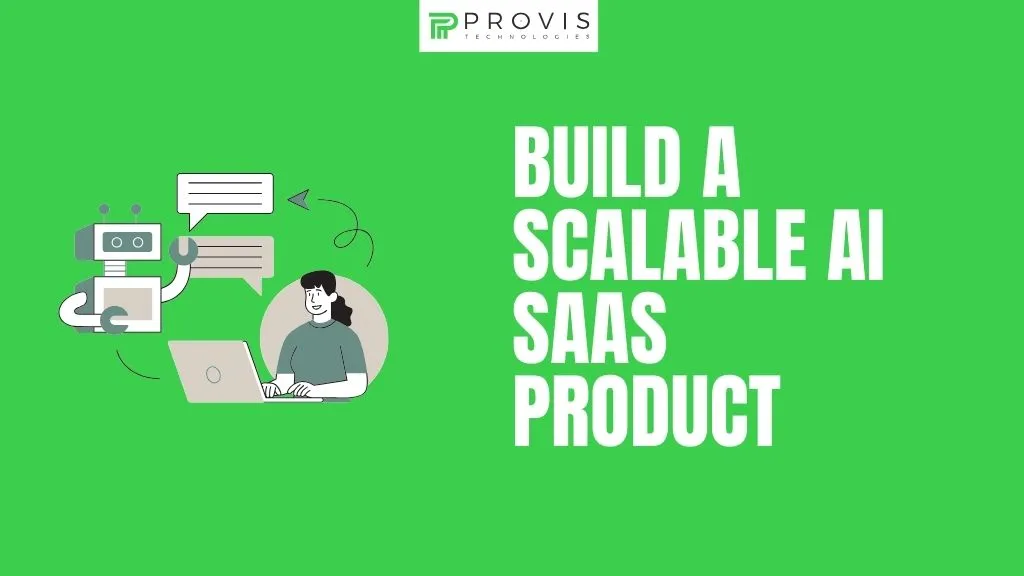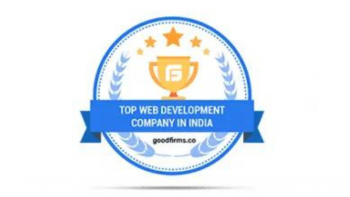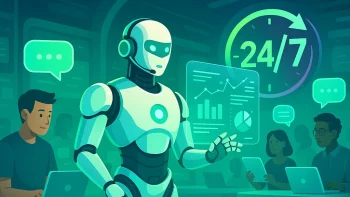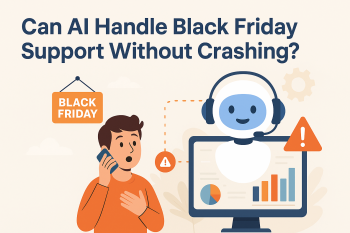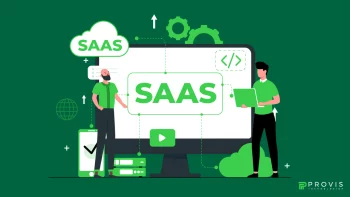The AI SaaS market is booming, and it’s not just us saying this! The Artificial Intelligence SaaS market stood at USD 71.54 billion in 2024 and is predicted to reach USD 775.44 billion by 2031, thus having a CAGR of 38.28% [1]. Impressive, right?
If you’re curious about tapping into this great potential and want a successful AI SaaS product development, this blog is for you!
Here, we’ll walk step-by-step through the process of AI SaaS product development. We’ll also give you a cost breakdown to help keep things in check.
Hold up! Before all that, let’s first understand SaaS products —
What is a SaaS product?
SaaS (Software as a Service) products are those software that can be used over the internet without the need to download and install it. You can consider it as the Netflix of softwares, where you do not need to download or install anything because everything functions on the cloud, and you only need to log in to use the application. In fact, SaaS products are very handy since you do not have to think about any maintenance, updates or even storage. All that is done by the provider while you have the service on any device.
A few renowned SaaS product examples include Google Drive, Slack, Dropbox – practically any software to which you directly connect via the internet.
Understanding SaaS and AI Integration
Now, let’s talk about how AI takes SaaS to the next level. When AI gets mixed with SaaS, it’s like giving your software superpowers. Here’s how:
You Get Customer Behavior Insights
AI-powered SaaS solutions collect a large volume of data from users. This is to say that adding AI to the data would help understand customer behavior patterns more thoroughly. AI can detect trends you never thought possible.
For example, predictive analytics (which is an advanced AI technique) is able to make projections about the tendencies and behaviors of sales, customers, and the environment. It’s wonderful that you have a business fortune-telling service.
You Offer Personalised Experiences
AI has tremendous capabilities in personalizing experiences across different areas. This is possible due to the analysis of a large amount of user-related information, allowing companies to adapt their experience to the application. Think of an AI chatbot that talks back to you in the same voice and mood. You now have a virtual assistant who understands you completely.
You Automate Boring Tasks
Let’s be real; no one wishes to do repetitive tasks. Yet, some work requires you to do boring, repetitive tasks, such as data entry and reporting. Such duties can be done away with by the use of models or AI-powered tools such as GPT. For instance, why spend so many hours filling out forms when you can use an AI chatbot for such tasks?
You Boost Security
AI can also strengthen the security of your SaaS product in many ways. For instance, an AI-powered SaaS solution can scan for threats and react to them immediately faster than any person can. It’s like having a security detail for your software around the clock.
Don’t Miss:-Optimizing SaaS Applications for the Cloud: Strategies for 2025
Steps to AI SaaS Product Development
AI SaaS product development may seem hard, but it’s not that complex; rather, it involves a step-by-step approach. Here is a SaaS development roadmap:
Step 1: Define Your Goals
Before going into the techy details, you will need to answer a couple of critical questions:
- Does your SaaS address any particular need?
- What do you want this AI-powered platform to do
- What does it matter to the users?
- And last but not the least – how is it going to benefit your business?
The above-mentioned questions will help you complete every other stage and will make sure that your product serves the purpose you intend.
Step 2: Conduct Market Research
Do your homework! Explore who the competitors are, how they are leveraging AI, and what the customers are demanding in the AI-based SaaS. It is like going for a market walk before launching a new outlet.
Step 3: Identify AI Capabilities and Features
Now, coming to AI! Choose what parts of the AI segment would be beneficial for your product. Wish to see where the market is heading? Use machine learning. Looking for customization? Deep learning has your back. Does your offering contain pictures? Computer vision – check. For things like customer support or sentiment analysis, natural language processing will fit in nicely.
Step 4: Prepare AI Training Data
AI doesn’t understand everything. It would be best to give it data to teach itself. Well-trained systems such as GPT or Llama are pretty effective but still require adjustment to fit your context.
For instance, a GPT chatbot will have no idea what product your business deals with unless trained on that.
Step 5: Choose the Right Tech Stack
Choose the tools and platforms that will be used to develop the product. This will be different based on what AI functionalities you want, but make sure it is aligned with your goals.
| Category | Tech Stack Options |
| Frontend Frameworks | React JS + Vite, Vue JS, Angular, Svelte |
| Frontend Design & Styling | Tailwind CSS, Bootstrap, Bulma, MUI, Shadcn/ui |
| Backend Development | Nest JS, Express JS, Rust Rocket, Django, Beego, Laravel |
| Database | MongoDB, PostgreSQL, PlanetScale DB, Timescale DB, Redis |
| Cloud & Hosting | Fly.io, DigitalOcean, Linode, Azure, AWS, GCP |
| AI/ML Models | OpenAI GPT, Google Gemini, Nitro, Jan.ai, LLAMA |
| APIs & Communication | REST APIs, GraphQL |
| No-Code Tools | Bubble.io |
Step 6: Train the AI Model
All the data you have collected will now be used to train your AI model. Consider it as molding the thought process of the AI being designed. Every input you give the model helps it learn in order to make better choices with artificial intelligence learning. This is the stage when you make all the necessary adjustments if you expect your AI to do things such as predict trends or answer questions from clients.
Step 7: Prepare the SaaS for Integration
Now that the AI has been trained and is ready to be deployed, the next step is to make sure it is integrated into the relevant SaaS product. This means linking the AI to the respective components of the SaaS product, be it chatbot, data analysis, or recommendations. Make sure everything flows smoothly so the AI works as intended within the app.
Step 8: Ensure Compliance and Data Security
AI needs great attention since it processes a lot of data. There is a need to ensure the safety of everything. After all, you would not want critical information regarding users to be exposed to third parties. Ensure that your offering is able to operate under the relevant laws protecting personal information, including GDPR and CCPA.
Step 9: Integrate and Evaluate the AI SaaS / Perform Quality Assurance
Do the necessary checks that will prove that the AI SaaS product works, and the end user will be satisfied with it. Identify the possible malfunctions of the software concerning the speed and quality of the services and the AI’s decision-making.
Step 10: Launch the AI SaaS App – Monitor and Improvise
You did it! You can now share the app with everyone! However, do not get too relaxed, as this is not the end of your responsibilities.
When your AI SaaS is up and running, monitor its performance. Interact with users and know how to modify and upgrade the AI as per demand. As always, it is about adapting and scaling to suit customers’ desires.
Must Know:- Chatbots for B2B SaaS: Harnessing The Power of AI for Business Growth
Cost Estimation for Building A Custom and Scalable AI SaaS Product
Developing an AI-based SaaS solution comes with varying pricing ranges. In most cases, it falls within the range of $30,000 to $300,000 or even higher, based on the product complexity and features desired. To give you an overview of the cost of SaaS product development:
| Platform Complexity | Average Timeline | Average Cost |
| Simple product with basic features | 4-6 months | $35,000 – $80,000 |
| Medium complex platform with moderate features | 4-9 months | $80,000 – $200,000 |
| Highly complex systems with advanced features | 9 months to 1 year or more | $200,000 – $400,000 or more |
Top 5 AI SaaS Integrated Platforms
Here are the top 5 scalable AI SaaS platforms in 2024 to look for —
| AI SaaS Platform | Key Features | Industry Focus |
| OpenAI | – Known for GPT-3 and DALL-E. | General AI and advanced language models. |
| Anthropic | – Focuses on developing safe and ethical AI systems. | Ethical AI and language models. |
| Google DeepMind | – Created AI systems like AlphaGo and AlphaFold. | AI research and machine learning applications. |
| Databricks | – Specializes in data engineering, machine learning, and real-time analytics for business insights. | Data engineering and AI analytics. |
| Cvent | – AI-powered event management platform for improving attendee engagement and business outcomes. | Event management and venue selection. |
Wrapping Up!
After all, AI SaaS product development isn’t that hard if you follow the procedure step by step. Work smartly, define your goals, research the market, and select the right AI features! You can seamlessly create a product that not only serves your business but also grows with it.
And yeah, make sure you keep an eye on the development costs — knowing where your money’s going will help you build smarter.
References:
https://www.verifiedmarketresearch.com/product/artificial-intelligence-saas-market/
Written By
Author's Picks
- Optimizing SaaS Applications for the Cloud: Strategies for 2025
- 23/09/2024
- How AI Is Shaping The Future Of Wealth Management – Benefits And Applications
- 19/09/2024
- How Augmented Reality (AR) Is Transforming E-Commerce Websites
- 14/09/2024
Categories
- AI for Startups
- AI in Web Development
- AI Integration
- AI Platforms
- AI Prompt
- AI Tools
- AI Trading Software
- Android App
- Android vs iOS Development
- Angular
- API
- API Development
- App
- app development
- App Idea
- App User Feedback
- Application
- Artificial Intelligence
- Audit Services
- Automotive Industry
- Awards and Recognition
- Business Consulting
- Business Website
- Chatbots
- CRM
- CRM for Financial Advisors
- Custom CRM
- Custom SaaS
- Custom Website
- Customer Service
- dashboard design
- Developing a Mobile App
- Digital Business
- E-commerce
- EMR Integration
- Finance
- Financial Advisors
- Financial Advisors
- GIT
- Health Insurance
- iOS App
- iOS App Development
- IoT Mobile App Development
- IoT Platforms
- IT Audit Services
- IT Consulting
- IT Strategies
- Java Development
- Laravel
- Lean Canvas
- Learning Management System
- Logistics Apps
- Mobile App Development
- MVP
- Native App
- News Aggregator Site
- OTT
- Outsourcing IT
- Payment Gateway
- predictive analysis
- Product Launch Strategy
- Progressive Web App (PWA)
- Prototype
- Recommender Systems
- Ruby
- SaaS
- SaaS Application
- SaaS Business
- SaaS Company
- SaaS Development
- SaaS Product
- SaaS Project
- Sales Funnel
- SEO
- Shopping Cart
- Software Development
- SSL and TLS
- Startup Checklist
- Technology
- Tetradic Color Scheme
- UI/UX Design Company
- Unit Testing
- User Flow
- User Testing
- Web Development
- Web Performance Optimization
- website Maintenance Services
- Website Migration Service
- Website Speed Optimization
- WooCommerce
- WordPress
